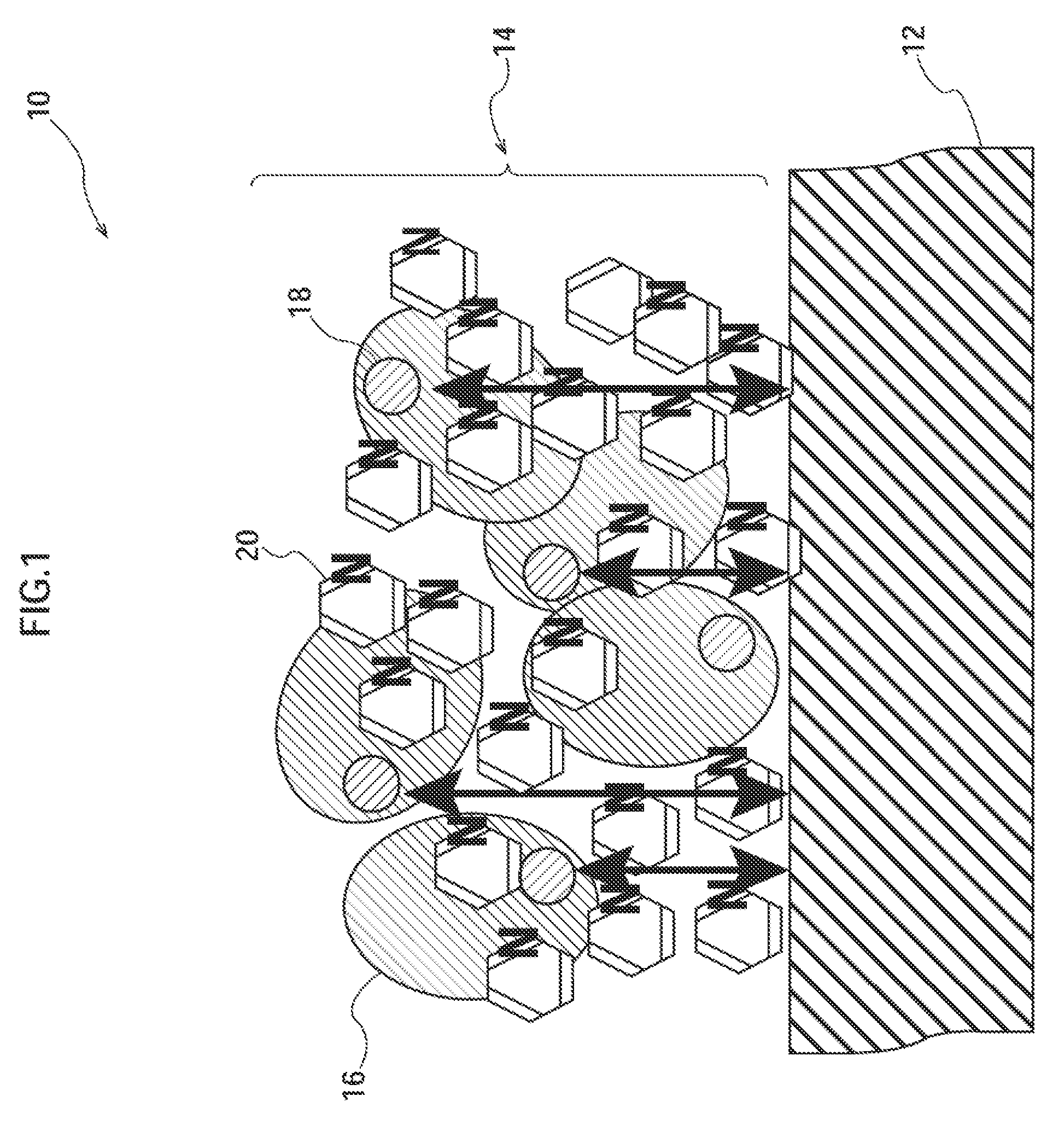Analysis device
a technology of electron transport mediator and metal complex, which is applied in the direction of liquid/fluent solid measurement, biomass after-treatment, enzymology, etc., can solve the problems of low reliability of long-term use, high cost of metal complex used as electron transport mediator, and complex manufacturing methods
- Summary
- Abstract
- Description
- Claims
- Application Information
AI Technical Summary
Benefits of technology
Problems solved by technology
Method used
Image
Examples
example 1
[0124](1) Production of Enzyme Electrode
[0125]For an enzyme electrode, Pt (Au) was sputtered on a polyimide (PI) film to obtain a substrate having a platinum layer. As an electrode material, a printing ink in which 40 wt % Ketjen black (manufactured by Lion Corporation) was mixed with 40 wt % polyester resin as a binder and 20 wt % isophorone as a solvent was used. The surface of the polyimide film was printed with the printing ink so that the printing ink had a thickness of 10 μm.
[0126]Then, an enzyme liquid containing 1,250 U / ml of a wild-type GDH solution (0.1M MES buffer solution), 1% adonitol as a stabilizer, and 1 wt % of 4-aminomethyl pyridine as a water-soluble aromatic heterocycle compound was prepared.
[0127]The prepared enzyme liquid was dropwise added to the surface of the electrode using a precise syringe, and thereafter, the resulting electrode was left to stand for 4 hours under the environment of 23° C. and a relative humidity of <8% to be dried, whereby an enzyme ele...
example 2
[0132](1) Production of Enzyme Electrode
[0133]For an enzyme electrode, Au was sputtered on a polyetherimide (PEI) film to obtain a substrate having a gold layer. As an electrode material, a printing ink in which 40 wt % Ketjen black (manufactured by Lion Corporation) was mixed with 40 wt % polyester resin as a binder and 20 wt % isophorone as a solvent was used. The surface of the polyetherimide film was printed with the printing ink so that the printing ink had a thickness of 10 μm, whereby a a working electrode was obtained.
[0134]Then, enzyme liquid containing 2,500 U / ml of a wild-type GDH solution (0.1 M MES buffer solution), 2% sucrose as a stabilizer, 1 v / v % glutaraldehyde as a crosslinking agent, and 1% of 4-aminomethyl pyridine as the aromatic heterocycle compound was prepared.
[0135]The prepared enzyme liquid was dropwise added to an electrode surface using a precise syringe and the resulting electrode was left to stand for 10 minutes at a normal temperature (23° C.) and a n...
example 3
[0142]Enzyme electrodes 3A to 3F were obtained in substantially the same manner as in Example 2 (1) except that the concentrations of 4-aminomethyl pyridine were in the range of from 1% to 6% in preparation of enzyme solutions. In the final form of the enzyme electrodes, the concentrations of from 1% to 6% correspond to dry masses of from 23% to 64%, respectively.
[0143]Measurement for 100 mg / dL glucose in 0.1 M phosphate buffer (pH 7.4) was performed using the enzyme electrodes 3A to 3F and the comparative enzyme electrode containing no 4-aminomethyl pyridine produced in Example 2 (1), at a measurement temperature of 37° C. The enzyme electrodes 3A to 3F and the comparative enzyme electrode; Pt; and Ag / AgCl were used as working, counter, and reference electrodes, respectively. The results are shown in FIG. 4.
[0144]As indicated in FIG. 4, it is found that glucose can be detected by setting the concentrations of 4-aminomethyl pyridine added in the enzyme solutions to the range of from...
PUM
| Property | Measurement | Unit |
|---|---|---|
| thickness | aaaaa | aaaaa |
| particle sizes | aaaaa | aaaaa |
| particle sizes | aaaaa | aaaaa |
Abstract
Description
Claims
Application Information
 Login to View More
Login to View More - R&D
- Intellectual Property
- Life Sciences
- Materials
- Tech Scout
- Unparalleled Data Quality
- Higher Quality Content
- 60% Fewer Hallucinations
Browse by: Latest US Patents, China's latest patents, Technical Efficacy Thesaurus, Application Domain, Technology Topic, Popular Technical Reports.
© 2025 PatSnap. All rights reserved.Legal|Privacy policy|Modern Slavery Act Transparency Statement|Sitemap|About US| Contact US: help@patsnap.com



